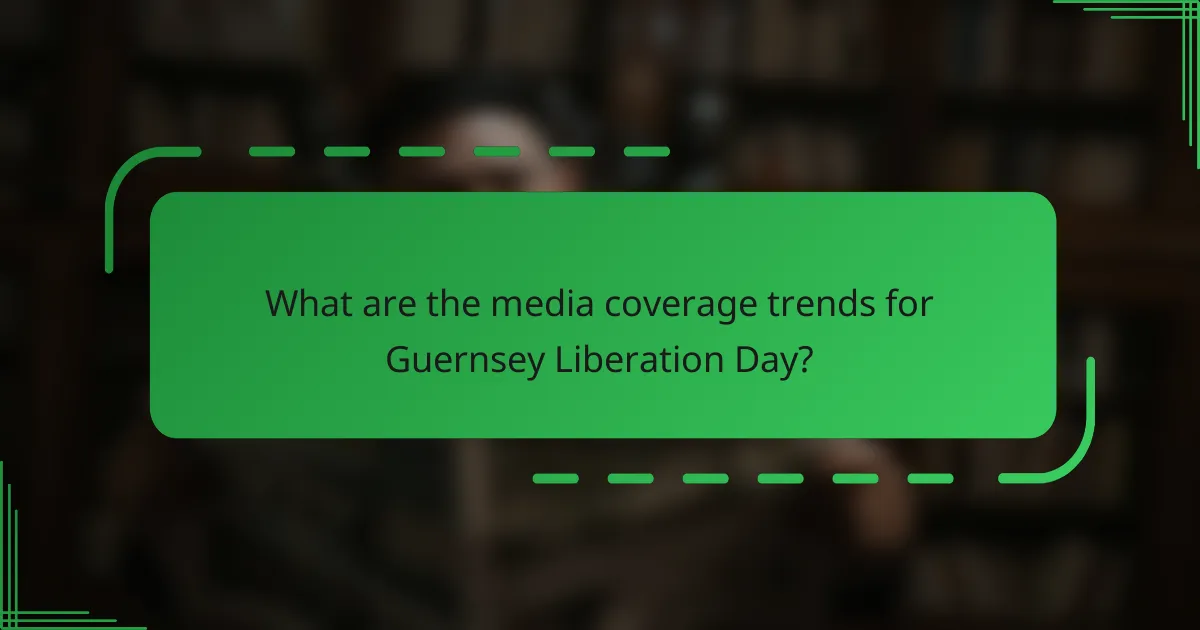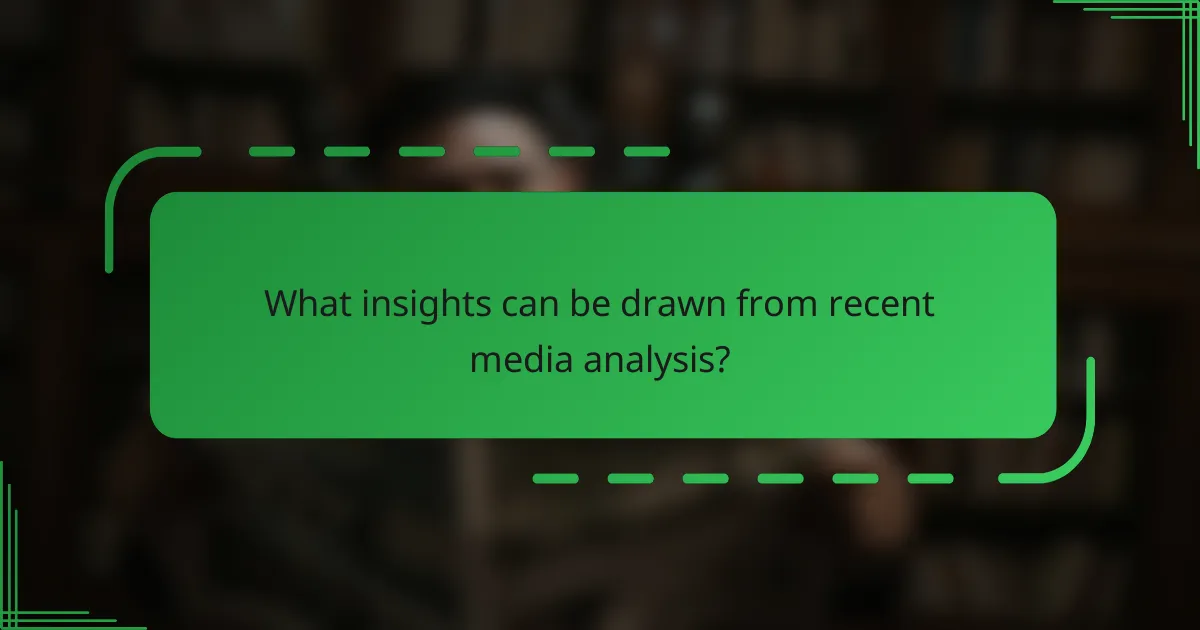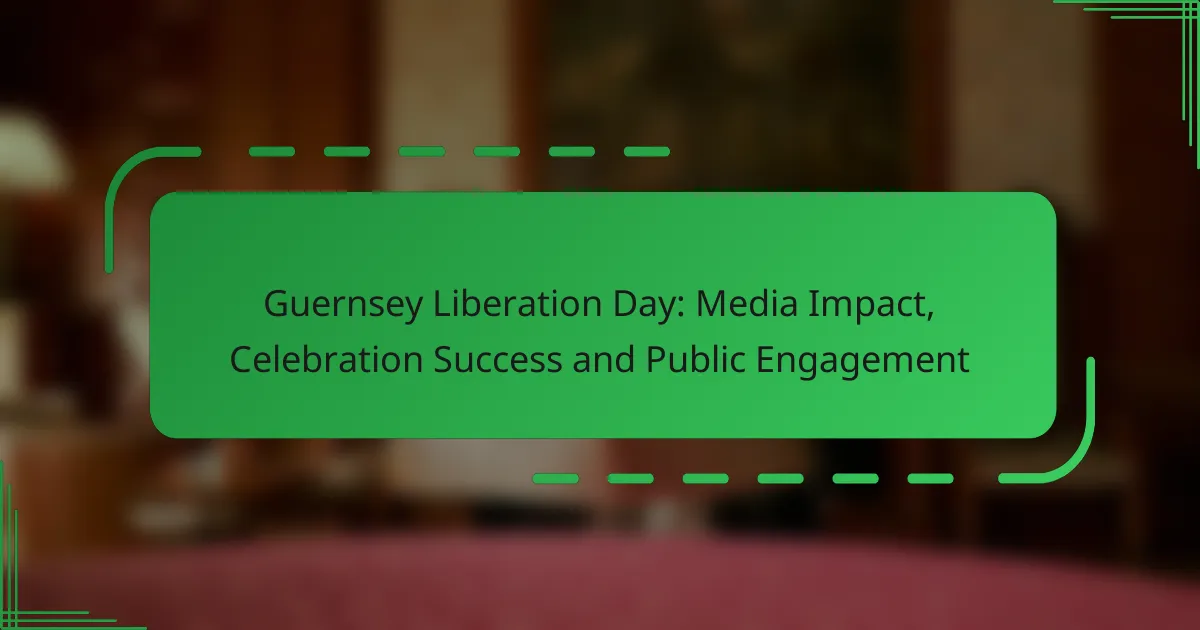Guernsey Liberation Day has seen a notable transformation in media coverage, with a marked shift towards digital platforms and social media that cater to evolving audience preferences. This change underscores the significance of local news outlets and the increasing appeal of video content, which effectively engages the community while celebrating the day’s historical importance and local festivities.

What are the media coverage trends for Guernsey Liberation Day?
The media coverage trends for Guernsey Liberation Day indicate a significant shift towards digital platforms and social media, reflecting changing audience preferences. This evolution highlights the importance of local news outlets and the growing popularity of video content in engaging the community.
Increased digital engagement
Digital engagement for Guernsey Liberation Day has surged, with more residents accessing news and updates online. Local websites and news portals have become primary sources for information, often featuring interactive content that encourages participation.
Events are now frequently live-streamed, allowing wider access for those unable to attend in person. This trend has fostered a sense of community among viewers, as they can share their experiences in real-time.
Shift towards social media platforms
Social media platforms have become essential for disseminating information about Guernsey Liberation Day. Channels like Facebook, Instagram, and Twitter are utilized to share event highlights, photos, and community stories, reaching a broader audience.
Engagement on these platforms often includes user-generated content, where residents post their own experiences and celebrations, creating a vibrant online community around the event.
Focus on local news outlets
Local news outlets play a crucial role in covering Guernsey Liberation Day, providing in-depth stories and features that resonate with the community. These outlets often highlight the historical significance of the day, connecting past events with present celebrations.
By focusing on local perspectives, news coverage fosters a deeper understanding of the day’s importance, encouraging residents to engage more actively in the festivities.
Emergence of video content
Video content has emerged as a dominant form of media coverage for Guernsey Liberation Day. Short clips and documentaries showcasing events, interviews, and historical narratives are increasingly popular.
This format not only captures the essence of the celebrations but also allows for emotional storytelling, making it easier for viewers to connect with the significance of the day.
Analysis of audience demographics
Understanding audience demographics is vital for tailoring media coverage of Guernsey Liberation Day. Analysis shows that younger audiences are more engaged with digital and social media, while older generations may prefer traditional news formats.
Media outlets are adapting their strategies to cater to these diverse groups, ensuring that content is accessible and relevant to all age ranges, thus maximizing participation in the celebrations.

How has Guernsey Liberation Day been represented in the media?
Guernsey Liberation Day has been prominently featured in the media, emphasizing its historical importance and the community’s celebrations. Coverage typically highlights the significance of the day while showcasing local events and interviews with notable figures.
Highlighting historical significance
The media often underscores the historical significance of Guernsey Liberation Day, which commemorates the island’s liberation from German occupation during World War II. Articles and broadcasts frequently detail the events leading up to the liberation and the impact on local identity.
Documentaries and special features may include archival footage and personal stories from residents who experienced the occupation, providing a deeper understanding of the day’s importance. This historical context helps to reinforce the collective memory of the island’s resilience.
Coverage of local events and celebrations
Local media extensively covers the various events and celebrations that take place on Guernsey Liberation Day, including parades, concerts, and community gatherings. These events are often highlighted as a way for residents to come together and celebrate their shared history.
Coverage typically includes interviews with participants and organizers, showcasing the vibrant atmosphere and the emotional significance of these gatherings. Social media plays a crucial role in amplifying these celebrations, with residents sharing their experiences and photos online.
Interviews with key figures
Interviews with key figures, such as local politicians, historians, and community leaders, are a common feature in media coverage of Guernsey Liberation Day. These discussions often focus on the day’s meaning and its relevance to contemporary society.
Such interviews provide insights into how the legacy of the liberation continues to shape Guernsey’s identity and values. They also highlight ongoing efforts to educate younger generations about the island’s history.
Comparative analysis with other national holidays
Media coverage frequently includes comparative analyses of Guernsey Liberation Day with other national holidays, such as Independence Day in the United States or Remembrance Day in the UK. These comparisons help to contextualize the significance of Liberation Day within a broader framework of national pride and remembrance.
Such analyses may explore themes of freedom, sacrifice, and community resilience, drawing parallels between different historical narratives. This approach enriches the public’s understanding of how various cultures commemorate their histories and values.

What insights can be drawn from recent media analysis?
Recent media analysis reveals that coverage of Guernsey Liberation Day has evolved, reflecting changing public sentiment and community engagement. Insights indicate a growing emphasis on local narratives and the role of influencers in shaping perceptions around this significant event.
Trends in public sentiment
Public sentiment surrounding Guernsey Liberation Day has shifted towards a more inclusive and celebratory tone. Many residents express pride in their heritage, with social media platforms showcasing personal stories and memories linked to the day.
Surveys indicate that a significant portion of the community feels a stronger connection to their identity during this celebration. This trend is evident in the increasing participation in local events, highlighting a collective appreciation for the island’s history.
Impact of media coverage on community engagement
Media coverage plays a crucial role in enhancing community engagement for Guernsey Liberation Day. Local news outlets and online platforms have been instrumental in promoting events, leading to higher attendance and participation rates.
Effective media campaigns often feature interviews with residents and historical insights, fostering a sense of belonging. This approach encourages more people to share their experiences, further enriching the community narrative.
Role of influencers in shaping narratives
Influencers have become key players in shaping the narratives around Guernsey Liberation Day. Their ability to reach diverse audiences allows for broader discussions about the significance of the day and its relevance to younger generations.
By sharing personal stories and engaging with their followers, influencers help to humanize the historical aspects of the celebration. This engagement often leads to increased interest and participation, particularly among those who may not have previously connected with the event.

What are the criteria for effective media coverage of local events?
Effective media coverage of local events, such as Guernsey Liberation Day, hinges on several key criteria that enhance community engagement and information dissemination. These include relevance to community interests, timeliness of reporting, and inclusivity of diverse voices.
Relevance to community interests
Media coverage must align with the interests and values of the local community to be effective. This means highlighting aspects of the event that resonate with residents, such as historical significance, cultural celebrations, and community participation. For Guernsey Liberation Day, focusing on local traditions and stories can foster a deeper connection with the audience.
To ensure relevance, media outlets can engage with community members before the event to gather insights on what topics are most important. This could involve surveys or social media polls to gauge public interest and expectations.
Timeliness of reporting
Timeliness is crucial for effective media coverage, especially for events like Guernsey Liberation Day, which may have specific dates and times that are significant to the community. Coverage should be prepared in advance and released promptly to capture the event’s atmosphere and immediate reactions.
Media outlets should aim to provide updates during the event, as well as follow-up stories that reflect on the day’s impact. This could include live reporting, social media updates, and post-event analyses to keep the community informed and engaged.
Inclusivity of diverse voices
Incorporating diverse voices in media coverage enriches the narrative and reflects the community’s varied perspectives. For Guernsey Liberation Day, this means including stories from different demographic groups, such as various age ranges, ethnic backgrounds, and local organizations.
To achieve inclusivity, media outlets should actively seek out interviews and contributions from a broad spectrum of community members. This approach not only enhances the coverage but also fosters a sense of belonging and representation among all residents.

How does Guernsey Liberation Day compare to similar events?
Guernsey Liberation Day is celebrated with unique traditions and significance, similar to other regional events like Jersey Liberation Day. The key differences lie in the scale of celebrations, media coverage, and public engagement, which reflect the distinct cultural identities of the islands.
Comparison with Jersey Liberation Day
Jersey Liberation Day, observed on May 9, commemorates the island’s liberation from German occupation, much like Guernsey’s celebration on May 9. However, Jersey’s events tend to attract larger crowds and more extensive media coverage, often featuring parades and public speeches from prominent figures.
While both islands celebrate their liberation with ceremonies and community events, Guernsey’s observance is often more intimate, focusing on local traditions and community gatherings. This difference in scale can influence the overall public sentiment and engagement during the celebrations.
Analysis of media coverage in the Channel Islands
Media coverage of Guernsey Liberation Day typically includes local news outlets highlighting community events, historical reflections, and interviews with residents. In contrast, Jersey’s Liberation Day garners broader attention from national media, resulting in more extensive reporting and analysis.
Social media plays a significant role in shaping public perception and engagement for both events. Guernsey’s coverage often emphasizes personal stories and local heritage, while Jersey’s media tends to focus on larger-scale festivities and political commentary.
Lessons from other regional celebrations
Looking at other regional celebrations, such as those in the Isle of Man or the Falkland Islands, Guernsey can learn the importance of engaging younger generations. Incorporating educational programs and interactive events can enhance participation and foster a deeper understanding of the significance of Liberation Day.
Additionally, leveraging digital platforms for broader outreach can help both Guernsey and Jersey enhance their visibility and attract visitors. By showcasing unique cultural elements and encouraging community involvement, these celebrations can grow in significance and participation over time.

What emerging trends are shaping the future of media coverage?
Emerging trends in media coverage are increasingly influenced by technology, audience engagement, and the evolving landscape of social media. These factors are reshaping how stories, such as Guernsey Liberation Day, are reported and consumed.
Increased Use of Digital Platforms
Digital platforms are becoming the primary medium for media coverage, allowing for real-time updates and broader reach. Traditional outlets are adapting by enhancing their online presence, utilizing social media to engage audiences directly. This shift enables more interactive storytelling, where viewers can participate in discussions and share their perspectives.
Focus on Localized Content
There is a growing emphasis on localized content that resonates with specific communities, such as Guernsey. Media outlets are tailoring their coverage to reflect local culture, history, and events, which fosters a stronger connection with the audience. This trend encourages the inclusion of local voices and perspectives, making the coverage more relevant and impactful.
Data-Driven Reporting
Data-driven reporting is becoming essential in media coverage, providing insights that enhance storytelling. Journalists are increasingly using analytics to understand audience preferences and tailor content accordingly. This approach not only improves engagement but also helps in measuring the effectiveness of coverage, allowing for adjustments in real-time.
Emphasis on Authenticity and Transparency
Audiences are demanding more authenticity and transparency from media outlets. This trend is prompting journalists to disclose sources, methodologies, and potential biases in their reporting. By being open about their processes, media organizations can build trust with their audience, which is crucial for maintaining credibility, especially during significant events like Guernsey Liberation Day.



